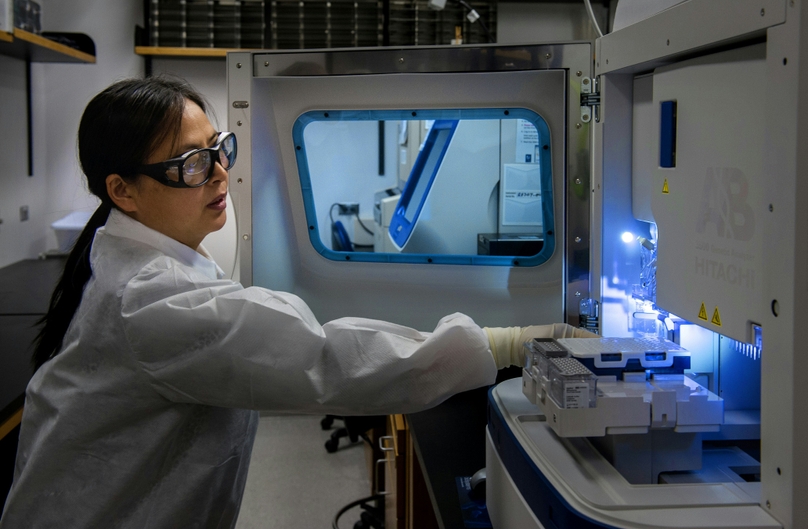What Is A Cloud-Based LIMS?
A laboratory information management system logs, tracks, records and reports on samples and scientific data in a structured, consistent manner. The high level of sample tracking and reporting that is possible with a LIMS makes it easier for compliance and laboratory best practices to be carried out and enforced. Because the recording of certain data becomes automatic with a LIMS, laboratories can pay closer attention to the handling and usage of samples and optimize their processes. Better sample maintenance and handling means more reliable experiments and results.
A cloud-based LIMS specifically stores your data in the cloud to grant access to the data from multiple systems across multiple locations. Each user has access to real-time and secure data on a company-wide scale. Other significant benefits of a cloud-based LIMS include:
Faster implementation time
Reduced need for internal IT support
Automatic updates
Higher security
What Can You Achieve With A Cloud-Based LIMS?
Improve Resource Utilization: The use of a LIMS makes it quick and easy to find samples, which saves time and cost trying to hunt down or potentially regenerate necessary samples.
Back-Up Data: Data is cumbersome and costly to manage on local systems. Backing up data off-site has greater flexibility, scalability and reliability with protection against local malfunctions and human error.
Navigate Regulatory Compliance: LIMS creates audit trails that accurately document sample storage, consumption, results and analysis. This level of automatic reporting and centralized data access allows for greater accountability by all lab members.
Balance Workloads: It’s extremely difficult to provide transparent information to a broad group when you’re managing on a local micro-level. When you employ a LIMS solution, built-in dashboards can improve oversight into the status of current tests, resources that are assigned and available, review status and more.
Enhance Workflow and Throughput: Human errors inherent in manual processes are inefficient, making it difficult to scale, share or report on your results. Create automated processes to reduce the stress and overhead required to perform daily tasks and research activities that are required to deliver results.
Standardize Laboratory Operations: Compliance requirements often center around ensuring your processes are fully validated within your user environment, making consistency of operations an extremely important aspect of any LIMS. Creating standardized and automated solutions helps reduce manual effort, resulting in lowered costs and more efficient operations.
The implementation of a LIMS platform brings control and transparency to the laboratory, improving efficiency through better workload management and automated reporting, improving compliance through built-in transparency and controls, and promotes faster and better decision-making through data utilization and informatics. Choosing the right LIMS system for your laboratory can transform daily operations, enabling you to achieve more with less and have confidence in every result generated.
How to Choose the Right LIMS For Your Lab
These days, almost every productive lab has a Lab Information Management System – a LIMS. LIMS originally were built to track and control workflows, but over the years their capabilities have greatly evolved and expanded. Just as no two labs are alike, there is a wide variety of LIMS on the market with features and capabilities that vary.
Before choosing a LIMS for your lab, you’ll want to consider the scope of your lab’s needs – as well as its budget. This will help facilitate knowing what to look for and how to choose.
Factors To Consider When Looking For a LIMS
Many of the LIMS on the market today are specifically designed for labs in certain industries such as pharmaceutical, biotech, life science development, and environmental, to name just a few. These LIMS are designed with features to specifically meet the needs of the labs in these industries. It would be an ineffective use of finances and resources, for example, to use a LIMS designed for QC testing in a life science lab.
Your lab’s need for flexibility will help you further narrow down your search. Some LIMS come with a range of out-of-the-box (OOB) functions, making them easy to use upon installation. While the most user-friendly design is preferable for some lab teams, a lab with specific unique needs and/or a strong IT department may prefer a LIMS that’s more customizable and configurable.
Budget is also an obvious but important consideration. While the ideal best LIMS may be (currently) out of your budget range, it’s possible that the next-best option is within your range. There is no such thing as a “perfect” LIMS – the important thing is having one that is configured to meet all of your lab’s essential needs.
Features To Consider In a LIMS
Once you’ve narrowed your search based on your lab’s industry/type and other basic factors, you can focus on which features are most essential and helpful to have.
If your lab is life sciences or biotech, then inventory management and sample management features will be important to your lab’s productivity. A LIMS that includes robust freezer inventory management software will help you keep your lab inventory well organized and make it easy to find samples and reagents, saving your team time, energy, and financial resources.
If your lab is life sciences or biotech, then inventory management and sample management features will be important to your lab’s productivity. A LIMS that includes robust inventory management software will help you keep your lab inventory well organized and make it easy to find samples and reagents, saving your team time, energy, and financial resources.
Preparing for audits and other reports can be time-consuming when pulling data and records from multiple systems, so consider a LIMS that has reporting features built-in to streamline this process. The best LIMS should also include features that ensure your lab is meeting and complying with regulatory standards.
If bandwidth, scalability, and customization are all important to your lab (along with all the other criteria mentioned so far), then you may seriously want to consider a cloud LIMS that is a SaaS, rather than on-premise. Cloud-based software allows lab teams to more easily collaborate with other teams, facilitating an online community of users. A SaaS LIMS is also low-maintenance, continually (automatically) upgraded, reduces the need for space/infrastructure, and offers secure access at all times.
Making The Right Choice
Finally, a less obvious but equally important feature to look for is reliable customer service support. The designers for the LIMS you’re using should be able to help you and your team troubleshoot whenever necessary and give advice on making the most of all the features and functions the software has to offer.
Choosing the right LIMS begins with understanding your lab type and industry, and more specifically your lab’s needs, as well as budget. There is a wide variety of LIMS on the market today and while there is no definitive “best” LIMS some are more technologically advanced and adaptable for growth than others. A cloud-based LIMS may be the best choice for many lab teams, considering cloud LIMS are typically designed for growth and scalability, come with a wide range of features, and are user-friendly.
If you are in the life sciences or biotech sector, consider choosing Genemod to help run your lab. Genemod is emerging as the go-to, cutting-edge software choice for research labs and has a wide range of solutions including user-friendly inventory management, and cloud-based automated software that allows for real-time collaboration, along with other robust features that help lab teams stay on track with tasks.
Learn The Steps You Need to Take for a Successful LIMS Implementation in 2024
A Laboratory Information Management System can bring your lab up to date and save you time and money. Read this article to learn about LIMS implementation.
What Are the Benefits of a New LIMS?
Laboratory information management systems are becoming more and more popular in modern laboratories due to technological advancements, software developments, increasing regulatory compliance requirements, and the growing demand for cloud storage solutions.
LIMS implementation entails replacing your current paper-based laboratory system with a digitized solution that has many benefits for members of the lab team and the productivity and efficiency of the company as a whole. Benefits include:
Improving functionality and workflow in the lab
Reducing human error in the lab
Optimizing project management
Streamlining data management and data migration
Moving one step closer to lab automation
Increasing information security
Providing full tracking of information and inventory
Improving quality control and assessment
6 Easy Steps For a Successful LIMS Implementation
LIMS implementation does not have to be overwhelming. But without the proper preparation, your lab can fall prey to missed deadlines, project delays, and inadequate use of the system.
You can avoid these pitfalls by careful planning and clear communication from the outset. By following these stages you can facilitate the introduction and deployment of a new LIMS in your laboratory and never look back.
Step 1: Choosing a LIMS Vendor
Choosing the right vendor is crucial. You need to make a selection that will suit your lab and please your stakeholders. For this reason, it’s important to draw up a list of vendors and vet each one to see if they suit your needs and your budget. A potential LIMS vendor, such as Genemod, should meet the following requirements:
Be able to explain their system without using jargon and buzzwords
Offer a flexible solution so you only pay for what you need
Have a LIMS with flexible architecture (accessible from a web browser, tablet, mobile phone, etc.)
Can answer all of your questions fully
Provide technology that is suitable for your business needs
Step 2: Determine your Lab Needs
At this stage, you will need to have drawn up a list of specific requirements for your LIMS. This will come from your understanding of your lab workflows. It’s worth taking your time with this, initially, so that you can cover every step in workflow and throughput, as this can save you time later. Some things to consider are:
What data you will store in your LIMS
Who will have access to what data
The type of data your LIMS should capture
The processes you use for labeling and tracking samples
What equipment you will be interfacing with your LIMS
Step 3: Setting Up Timelines for the LIMS Implementation
LIMS systems take time and money to implement and the whole procedure can be quite complicated. You need to make sure that you don’t skip any important steps otherwise you are going to encounter serious problems. When you’re coming up with a project plan, you need to include the following:
Look to the future: When you’re thinking of your LIMS needs, look for a dynamic system that can grow and your lab grows.
Allow yourself time: Add extra time for things like vendor demonstrations and bringing together stakeholder groups for discussion.
Remember infrastructure planning: Make sure the LIMS you choose can support all your bandwidth needs, such as sample collection.
Do a pilot test: Shifting from paper to digital can be a big adjustment. Give your team members adequate training and time to get used to the new system.
Don’t forget automation: If you have equipment in your lab that you can interface with your LIMS, do it as soon as possible. When it’s time to consider new equipment purchases, think about updating to newer technologies that can be added to your interface.
Create a validation plan: This will help you ensure that your new LIMS is functioning properly at the outset and continues to fulfill its intended use, meets requirements, and satisfies compliance regulations.
Step 4: Detailing the New System’s Functionality
From the get-go, you and your team need a thorough understanding of which aspects of laboratory management the LIMS will be responsible for. A LIMS is not merely for data management and data migration but has a much wider range of lab and business processes including:
Inventory and sample management
Instrument interfaces
Laboratory informatics
Analyzation of metrics
Helping meet regulatory requirements
Improving throughput
Test scheduling
Report generation
Quality control and quality assurance
Statistical analysis
Step 5: Training End-Users
Training your team to use LIMS should be done as quickly and efficiently as possible so that you can have all your team members on the same page and get the LIMS running at full capacity.
Bear in mind that interfacing successfully with the new LIMS can take some time and everyone needs to develop an understanding of all the system's abilities. Training should include the following aspects:
LIMS software overview: How a LIMS works and how to connect to the application. An explanation of general features and interfaces. Navigating the system and understanding security.
Dashboard: Which features and functions are available to which team members? How to access features. How to input and search for data.
Data storage: How can you make the most of the LIMS to maintain consistent record keeping? How to optimize efficiency and your data management across site maps.
Specific functions: How is information reported, searched, and shared? How to use site maps and search bars.
Sample tracking: How can sample batches be tracked as a group?
Equipment analysis: Using LIMS to keep a record of which user performed which tests in preparation for audits and reporting.
Quality: How can a LIMS be used to streamline quality assessment and quality assurance?
Step 6: Executing Your Go-Live Plan
This is the step where the LIMS software is rolled out. Now it’s time to inform your stakeholders that there’s new project management in your lab. You should have already trained your staff and prepared them for the initial deployment. Your go-live plan should also include:
The date and time that you go live
The name and position of the person initiating the LIMS
A regularly updated schedule for lab team members
How and when team members can utilize your existing system during the initial implementation
Time and date of data backup to prevent information loss
How existing data is impacted by the new system
Simplify Project Management with a LIMS from Genemod
Genemod is a LIMS vendor that stands above the rest, not only because of its flexible software solutions but also its reasonable pricing. With a Genemod LMS, end-users have optimal efficiency, productivity, and functionality at their fingertips. Successful LIMS implementation makes project management a breeze.
LIMS software streamlines interfacing, allowing you to input, store, and share data effortlessly. What’s more, buying a new LIMS solution will not upset your budget, so your team and your stakeholders will be happy. Contact Genemod today to find out more about how our LIMS can help your lab.


















